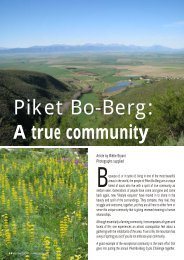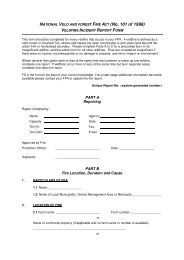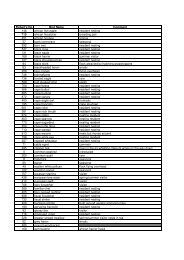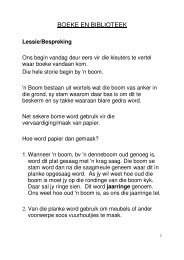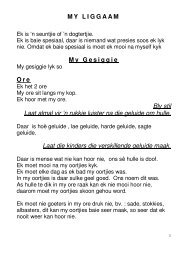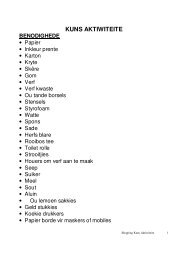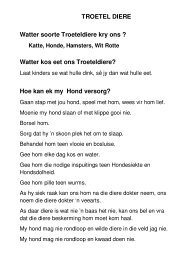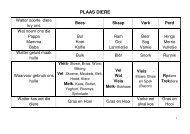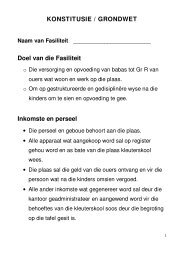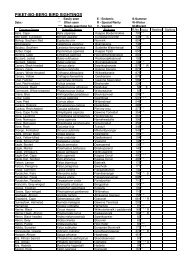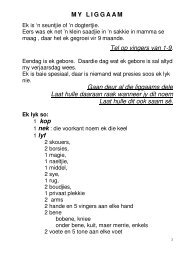The History of Piket Bo Berg JOHN PAULUS EKSTEEN VERSFELD
The History of Piket Bo Berg JOHN PAULUS EKSTEEN VERSFELD
The History of Piket Bo Berg JOHN PAULUS EKSTEEN VERSFELD
Create successful ePaper yourself
Turn your PDF publications into a flip-book with our unique Google optimized e-Paper software.
knew better and warned him that he was bound to fail. He wanted to be his own master; he had saved<br />
a few hundred pounds, he had a flock <strong>of</strong> merino sheep, his faithful shepherd Danje Engelbrecht with<br />
wife and children, besides a farmhand and his wife. “And so, with Mother to stand by him,” said his<br />
daughter Jessie, “(he never did anything without her whole-hearted co-operation,)” he moved there<br />
with his young wife and two little daughters, a wagon and a span <strong>of</strong> mules, horses and a cart.<br />
<strong>The</strong> farmhouse was quite primitive, with mud floors and no ceilings or glass in the windows; the first<br />
night a leopard jumped into the sheep-kraal and carried <strong>of</strong>f a sheep.<br />
When John arrived on the <strong>Piket</strong>berg Mountain the only people making a living there were the Lucas<br />
family, a widow and her four sons, living on a neighbouring farm Tweefontein.<br />
<strong>The</strong>y were industrious and very skilled at growing and making roll tobacco; their Lucas brand was<br />
considered to be the best obtainable, and they retained this reputation until their descendants gave up<br />
tobacco for fruit-growing. <strong>The</strong> Lucas’s taught John this line <strong>of</strong> farming, which he pursued with<br />
success; in his turn he was able to show them the advantage <strong>of</strong> merino sheep farming over the stock<br />
they were keeping.<br />
John’s daughter, Jessie, writes, “When I was born in mid-winter they say I never saw the sun for a<br />
fortnight, and Papa used to ride over to Voorste Vlei in the pouring rain every day to try to save his<br />
lambs, but they all died. It was no wonder that the lonely life began to tell on Mother’s health and<br />
Papa decided that he had been wrong to bring her so far from civilization. He has <strong>of</strong>ten told us how he<br />
had written an advertisement for the farm when Mother came along and made him tear it up and said<br />
she would try again. One <strong>of</strong> her sisters came to stay with her and from that time there was never any<br />
thought <strong>of</strong> giving up.”<br />
Life on the mountain top was hard for the young people. But John found a source <strong>of</strong> help and strength<br />
in the Mission <strong>of</strong> Goedverwacht, which lay deep in the valley below his farms Langeberg and<br />
Voorstevlei. Without the support <strong>of</strong> the Mission they would scarcely have been able to carry on.<br />
Among John Versfeld’a achievements on the mountain was a gravel road he made into Goedverwacht<br />
valley. When he wanted to ride to Malmesbury or Darling where his father lived, he followed the<br />
narrow road he had made along the mountain side, which drops steeply to the valley below, then along<br />
the river to Goedverwacht and out onto the plain. This is the road the Mission folk used to take to join<br />
in social events on the mountain<br />
To get to <strong>Piket</strong>berg village from the mountain top in those days was no easy matter. When a new baby<br />
had to be christened John and Mary took the cart as far as possible, then they rode down the bridlepath,<br />
servants carried the baby and toddlers, and the harness was laid on two spare horses. A cart was<br />
kept at Deze Hoek, where the nearest neighbours <strong>of</strong> their own kind farmed. From Deze Hoek they<br />
drove to <strong>Piket</strong>berg where the Minister, the Magistrate and the Schoolmaster lived – as yet there was no<br />
doctor. Here they could converse with educated people: their mountain neighbours were hardworking,<br />
kindly but illiterate folk.<br />
In 1872 John bought the largest and best farm on the mountain – Moutonsvallei, for £1,000 cash. He<br />
immediately began to build a new, spacious house beside it, and except for one large addition a few<br />
years later, it was much the same until fairly recently. It lies in a sheltered valley, protected by the<br />
mountain behind.<br />
<strong>The</strong>n John began planting trees and fruit trees all over his land. Molly D’Arcy Thompson writes, “A<br />
hundred years earlier, however, somewhere about 1780, an unknown man, perhaps a Mouton, came<br />
into the wilds and planted a wonderful garden. Its boundary fences were dog-rose hedges many feet



